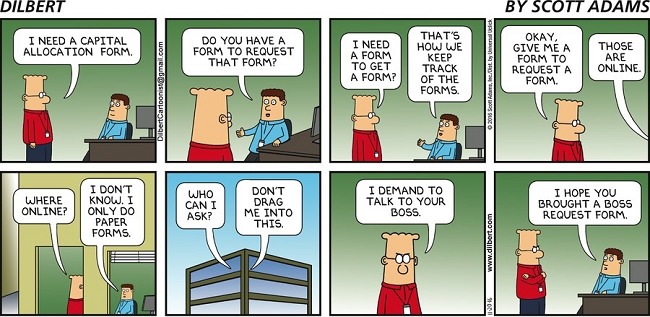“New Entrant v Incumbent: Chapters”]New Entrant v IncumbentTwitter Wars. Minimum Viable PoliticanThis post isn’t about politics. It’s about Startups battling an incumbent, the market leader.
Political campaigns are constructed as collapsible corporations, in startup jargon they are short-lived unicorns. This is the start of a post-mortem, we’ll break the campaigns and apparatuses into small pieces, examine what happened, why and consider alternatives.
I have been involved in politics for a long time. In Presidential races I vote one way or the other but I try to preserve myself as a disembodied intellect. Not a participant, just a spectator.
Through-out the election, until mid September, I had regular social visits with both campaigns.
“The Incumbent. Hillary Clinton Headquarters. Mid July. 300+ employees”]”10441″ onclick=” The New Entrant. Donald Trump Headquarters. Mid July. 10+ employees”]
Incumbent
Building too high: Initiated as a hierarchy, it resembles the bureaucratic, inefficient, structure seen in government. Prematurely they develop a small circle of generals and lieutenants, radiating from those are sergeants and further from those are lots of filled desks.
Productivity: Brute force is situationallt when willing to compromise quality for quantity. In a professional services organization it is common to overhire in sales during recessionary times so you can get as many ‘looks’ as possible. When the economy turns you thin sales force out by forcing attrition, implementing a rigid quota system, rewarding those you achieve it , implicitly punishing those who don’t. However when applied in the wrong situation, it is reckless. Without quotas employees can easily confuse the most bare minimum requirements of the job with a job well done, it all looks the same. You lose an incentive for discretionary effort.
Hoarding employees: This can become a vanity metric and worse, can become a risk of a different type. It’s hard as f**k to fire employees and people will benchmark themselves against the minimal performer, rather than the maximum.
Sub-optimal time usage for a too large group: Staffers with little to do is a major cause of poorly structured and overly long meetings that initiate with a vague agenda and complete with an agreement for another vague meeting.
Creating fiefdoms: Over staffing marketing, clerical, branding, and all the other cogs of a business fortifies into fiefdoms, and fiefdoms create a dual allegiance, to the fief to which you belong and secondarily to the employer.
Discourages ‘out of the box’ thinking. In a stratified workforce employees adopt a group think, they all reinforce each others soundbites. This is not to say members within the group wont raise their hands during meetings, but the query or observation stays within the bandwidth of the acceptable, it keeps within a range of M to P, anything outside that is shunned and the managers view this as a decaying of their management structure and purpose.
Loss of reflexivity: Too much democracy is dangerous. Companies of a smallish side should be a benevolent dictatorship. Some ill prepared generals might perceive consensus as lowering risk ‘we all agree’ but each participant will defend a poor group decision.
Manager overload: Permitting managers too much responsibility for hiring and firing is a major problem for a company that is built to large. Managers are usually poorly trained themselves, instead they try to recreate their former employer or an academic course.
Too many evangelists: There are strengths to brute force: It is a display of firepower, this has an effect on your opponent. Businesses are emotional things that have anxieties and such a large show of force will be intimidting. Brute force can have a residual value, as you pare down the employee count, missed opportunities are converted by those that remain. Another benefit is that brute force puts a lot of evangelists on the streets. However in the instance of HRC and the NYC HQ, this was actually detrimental and a significant drain on their resources and allocation of time, money and thruput. Those staffers were largely from NYC and were already HRC voters, as is their radius of family and friends, persuading the persuaded.
New entrant
Building low: Hiring fewer people lowers risk of firing people, which is, of course, very disruptive to a small company.
Flat: A lean assembly works well when you expect to be rapidly changing job descriptions. Small staffs can be quickly responsive to new feedback, information and changed direction. When employees have close proximity to the CEO their work can be more closely aligned with their personal identity, they gain impactful acknowledgment rather than a company paid gift card.
Desk cost: If an organization is kept lean more exacting calculations can be formulated per job type.
Overdosing on low hanging fruit: Market leaders will typically incorporate a counter strategy of winning by attrition, starving the new entrant. They will likely have the cash, resources, ancillary products and operational excellence to withstand most challengers. A market leader will allow new entrants to gobble away territory on the periphery, they will be tolerant of losing ‘low’ hanging fruit.
Staggered hiring: By staggering hiring the new entrant can preserve its ability to hire,. It can grow while the incumbant can’t shrink. Internal culture can be built on proximity to the founder and that cascades to the aspirations and discretionary output of the employees.
22Nov
New Entrant v Incumbent. Trump v HRC #startup

